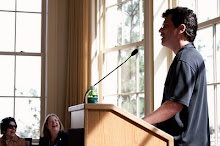In another online venue, among the reactions to my posting earlier today…
http://sharpelvessociety.blogspot.com/2011/12/view-from-beechen-cliff.html
…it was suggested that this watercolour portrait by Cassandra would have been typical ofa strong and widespread artistic tradition, particularly in illustrations for picturesque books and romances.
I at first responded by pointing out that Cassandra’s portrait was different from pictures painted in that tradition, because Cassandra’s portrait had virtually nothing at all eye-catching in it _except_ the woman portrayed from behind. Now I realize that I failed to grasp the full significance of that tradition, in terms of how it makes the in-joke between Cassandra and JA that much wittier and more profound.
To wit: the large blank space of canvas that take up almost exactly half of the space within the frame is precisely where there _should_ have been a picturesque view! Everything that we see in the picture points this way: the woman seated between two rocks, some shrubbery to her right, but in front of her, absolutely nothing!
I.e., this set-up announces to the viewer that it is a _parody_ of all those paintings in that hoary artistic tradition, it’s a send up that says, in so many words, that the picturesque depictions in all those paintings might be a tad overrated and overdone!
And that further interpretation aligns the passage in NA at Beechen Cliff that much more closely with Cassandra’s portrait:
“…Catherine was so hopeful a scholar that when they gained the top of Beechen Cliff, she voluntarily rejected the whole city of Bath as unworthy to make part of a landscape. Delighted with her progress, and fearful of wearying her with too much wisdom at once, Henry suffered the subject to decline, and by an easy transition from a piece of rocky fragment and the withered oak which he had placed near its summit…”
What better way to illustrate Catherine’s rejection of "the whole city of Bath as unworthy to make part of a landscape", than to delete the landscape entirely from the painting—but the humor comes from leaving in the observer next to “a piece of rocky fragment and the withered oak which he had placed near its summit.” It’s the very essence of theater of the absurd, the deletion of an essential element from a picture, instead of simply tossing the entire thing in the circular file!
And i was about to conclude by pointing out that I am certain that this painting, whatever the year of its composition (I have seen guesses for 1802, 1804 and 1810, respectively, in my quick search a few minutes ago), is inextricably linked to that very same passage in Northanger Abbey, and so, by being the first to connect them, I dub this portrait the Beechen Cliff Portrait. But then it occurred to me as I was about to post this, that if it was actually painted by Cassandra _at_ Beechen Cliff, then that would suggest that it was painted during the Bath years, i.e, 1801-1805---as Bart Simpson would say, DOH!!
Cheers, ARNIE
Popular Posts
- Deirdre Le Faye & Me: "I am a scholar, she is a scholar: so far we are equal"
- Darcy's "We neither of us perform to strangers": a Radical New Interpretation
- The Hunger Games’s Veiled Allusion to Shakespeare’s Titus Andronicus
- Rick Santorum would have been the worst person in the world to Jane Austen too!
- August Wayne Booth in Once Upon A Time: Jane Austen Really IS Everywhere in 2012!
- 20 shades of hero/villain Mr. Darcy
- Can Jane Austen forgive Marianne?
- Miss Bennet, Elizabeth, Lizzy, Eliza: who calls her what....and why
- The Great Gadsby: an overnight lesbian feminist ‘comedy’ sensation 10+ years in the making (& 3 millenia overdue)
- Austenland: The Movie was Fun, but the Novel was Better [SPOILER ALERT as to both]
Wednesday, December 21, 2011
Subscribe to:
Post Comments (Atom)

No comments:
Post a Comment